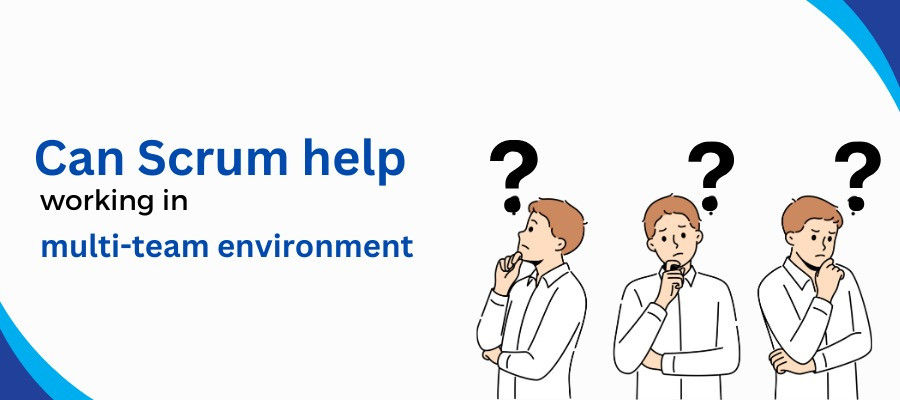Can Scrum Help Working In A Multi-Team Environment?

Scrum is a well-established Agile framework that emphasizes collaboration, adaptability, and iterative development. It's widely known for its core accountabilities and events, including Scrum Masters, Product Owners, Sprints, Daily Scrum, and more.
However, what happens when you work in a complex multi-team environment? Can Scrum handle such complexities? Indeed, Multi-Team Scrum can resolve all the problems! If you are hearing this for the first time, let’s explore the concept of Multi-Team Scrum. Keep reading as we discuss how it can help Scrum Masters manage multiple teams in complex environments.
What is Multi-Team Scrum (MTS)?
Multi-Team Scrum is a unique approach that extends the principles of Scrum to coordinate multiple teams working on the same product. The goal is to maintain the agility and customer-centric focus of Scrum while allowing for the scalability required in large and complex projects. MTS does not reinvent Scrum; instead, it enhances it to suit the needs of multi-team environments.
Managing Multiple Teams in a Scrum Project:
One of the most common scenarios where Multi-Team Scrum is applied is when a software company undertakes a complex web application development. In the traditional Scrum setup, one Scrum Team handles such a project. However, in the multi-team environment, several Scrum Teams work in tandem, each contributing its expertise to different aspects of the application.
Now, let's delve deeper into how Multi-Team Scrum operates in such scenarios:
#1 Example of Scaling:
Imagine a scenario where a software company is developing a complex web application. Traditionally, one Scrum Team with one Scrum Master and multiple Developers used to work on the same Product Goal. However, the process became complex with the involvement of multiple teams. Each team follows Scrum principles independently but must coordinate their efforts to deliver a cohesive product.
#2 Structural Patterns:
To manage multiple teams effectively, several structural patterns can be applied. These include:
- Feature Teams: In this approach, each team specializes in a specific feature or functional area of the application. For instance, one team might focus on the user authentication module, while another takes charge of the payment processing module. This specialization allows teams to develop deep domain knowledge and deliver high-quality features.
- Component Teams: Alternatively, the Agile Leader can form the teams based on the application modules. Each team works on a particular Product Feature. This division enables parallel development and integration of different components.
- Scrum of Scrums: To ensure alignment and coordination across teams, regular Scrum of Scrums meetings are conducted. These gatherings involve representatives from each team and are designed to address cross-team dependencies and impediments. This way, issues can be identified and resolved collaboratively, promoting a smooth flow of work.
#3 Governance Patterns:
Governance patterns help ensure that the project maintains its focus on delivering value. Key governance patterns include:
- Product Owner Teams: When the scope and complexity of the project exceed the capacity of a single Product Owner, multiple Product Owners can collaborate. These Product Owner teams share the responsibility of managing the product backlog, prioritizing features, and ensuring alignment with the overall project vision.
- Definition of Ready (DoR) and Definition of Done (DoD): In a multi-team environment, it becomes essential to establish clear and standardized criteria for what constitutes a ready backlog item (DoR) and what defines a completed increment (DoD). This consistency ensures that all teams adhere to the same quality and acceptance standards.
- Release Streams: Coordinated release planning and execution across teams become imperative in large-scale projects. Release streams synchronize the delivery of increments from various teams, ensuring that they integrate seamlessly and can be released to customers at regular intervals.
#4 Managing Transformations:
Implementing MTS often involves a transformation of organizational culture and practices. This may require:
- Coaching and Education: Providing Agile training and coaching for teams and leadership to ensure a shared understanding of Agile and Scrum principles.
- Learning from Experience: Encouraging teams to reflect on their experiences and continuously improve their processes.
Top Challenges of Multi-Team Scrum:
While Multi-Team Scrum offers significant benefits, it's not without its challenges. Some common challenges include:
- Communication and Coordination: Coordinating multiple teams can be complex, and communication breakdowns can hinder progress.
- Role Clashes: In a multi-team environment, role responsibilities may overlap or conflict, requiring clear delineation.
- Scaling Scrum Artifacts: Scaling Scrum requires adapting the traditional artifacts (e.g., Product Backlog, Sprint Backlog) to work effectively across teams.
- Resistance to Change: Transforming to MTS may face resistance from teams and leadership accustomed to traditional methodologies.
Key Takeaways:
Scrum isn't limited to small, single-team projects. With the right approach and mindset, Scrum can indeed help organizations thrive in multi-team environments, delivering value to customers efficiently and effectively.
As the growth of the Agile community continues, it's essential for Agile Practitioners to explore and adapt frameworks like Multi-Team Scrum. It offers a framework that extends the benefits of Scrum to complex multi-team environments. Organizations can harness the power of Scrum while scaling it to meet the demands of large and intricate projects.
You can refer to the Scrum Guide's Multi-Team Scrum Resources and the Scrum Handbook for further insights!
Reference:
https://scrumguide.org/resources/descriptions-of-scrum/multi-team-scrum/



